#agricultural planting
Text
dear mojang
add more crops in minecraft im begging you im on my hands and knees give us tomatoes give us onions give us strawberries give us peppers
add more food recipes please give us sandwiches give us more pastries give us pudding or some shit
sincerely, the farmer of every minecraft server
#'just play it modded-' NO I WANT IT IN THE ACTUAL GAME#I WANT MORE FARMING I WANT MROE FOOD#I DONT WANT MORE MOBS OR MINERALS OR PLANTS I WANT CROPS I WANT RECIPES#we need an agriculture update i would go crazy over that#mojang please#please#miles rambles#minecraft
19K notes
·
View notes
Text
I will write this thought about Veganism and Classism in the USA in another post so as to not derail the other thread:
There are comments in the notes that say meat is only cheaper than plant based foods because of subsidies artificially lowering the price of meat in the United States. This is...part of the story but not all of it.
For my animal agriculture lab we went to a butcher shop and watched the butcher cut up a pig into various cuts of meat. I have had to study quite a bit about the meat industry in that class. This has been the first time I fully realized how strongly the meat on a single animal is divided up by socioeconomic class.
Like yes, meat cumulatively takes more natural resources to create and thus should be more expensive, but once that animal is cut apart, it is divided up between rich and poor based on how good to eat the parts are. I was really shocked at watching this process and seeing just how clean and crisp an indicator of class this is.
Specifically, the types of meat I'm most familiar with are traditionally "waste" parts left over once the desirable parts are gone. For example, beef brisket is the dangly, floppy bit on the front of a cow's neck. Pork spareribs are the part of the ribcage that's barely got anything on it.
And that stuff is a tier above the "meat" that is most of what poor people eat: sausage, hot dogs, bologna, other heavily processed meat products that are essentially made up of all the scraps from the carcass that can't go into the "cuts" of meat. Where my mom comes from in North Carolina, you can buy "livermush" which is a processed meat product made up of a mixture of liver and a bunch of random body parts ground up and congealed together. There's also "head cheese" (made of parts of the pig's head) and pickled pigs' feet and chitlin's (that's made of intestines iirc) and cracklin's (basically crispy fried pig skin) and probably a bunch of stuff i'm forgetting. A lot of traditional Southern cooking uses basically scraps of animal ingredients to stretch across multiple meals, like putting pork fat in beans or saving bacon grease for gravy or the like.
So another dysfunctional thing about our food system, is that instead of people of each socioeconomic class eating a certain number of animals, every individual animal is basically divided up along class lines, with the poorest people eating the scraps no one else will eat (oftentimes heavily processed in a way that makes it incredibly unhealthy).
Even the 70% lean ground beef is made by injecting extra leftover fat back into the ground-up meat because the extra fat is undesirable on the "better" cuts. (Gross!)
I've made, or eaten, many a recipe where the only thing that makes it non-vegan is the chicken broth. Chicken broth, just leftover chicken bones and cartilage rendered and boiled down in water? How much is that "driving demand" for meat, when it's basically a byproduct?
That class really made me twist my brain around about the idea of abstaining from animal products as a way to deprive the industry of profits. Nobody eats "X number of cows, pigs, chickens in a lifetime" because depending on the socioeconomic class, they're eating different parts of the animal, splitting it with someone richer or poorer than they are. If a bunch of people who only ate processed meats anyway abstained, that wouldn't equal "saving" X number of animals, it would just mean the scraps and byproducts from a bunch of people's steaks or pork chops would have something different happen to them.
The other major relevant conclusion I got from that class, was that animal agriculture is so dominant because of monoculture. People think it's animal agriculture vs. plant agriculture (or plants used for human consumption vs. using them to feed livestock), but from capitalism's point of view, feeding animals corn is just another way to use corn to generate profits.
People think we could feed the world by using the grain fed to animals to feed humans, but...the grain fed to animals, is not actually a viable diet for the human population, because it's literally just corn and soybean. Like animal agriculture is used to give some semblance of variety to the consumer's diet in a system that is almost totally dominated by like 3 monocrops.
Do y'all have any idea how much of the American diet is just corn?!?! Corn starch, corn syrup, corn this, corn that, processed into the appearance of variety. And chickens and pigs are just another way to process corn. That's basically why we have them, because they can eat our corn. It's a total disaster.
And it's even worse because almost all the USA's plant foods that aren't the giant industrial monocrops maintained by pesticides and machines, are harvested and cared for by undocumented migrant workers that get abused and mistreated and can't say anything because their boss will tattle on them to ICE.
8K notes
·
View notes
Text
"Marginal improvements to agricultural soils around the world would store enough carbon to keep the world within 1.5C of global heating, new research suggests.
Farming techniques that improve long-term fertility and yields can also help to store more carbon in soils but are often ignored in favor of intensive techniques using large amounts of artificial fertilizer, much of it wasted, that can increase greenhouse gas emissions.
Using better farming techniques to store 1 percent more carbon in about half of the world’s agricultural soils would be enough to absorb about 31 gigatons of carbon dioxide a year, according to new data. That amount is not far off the 32 gigaton gap between current planned emissions reduction globally per year and the amount of carbon that must be cut by 2030 to stay within 1.5C.
The estimates were carried out by Jacqueline McGlade, the former chief scientist at the UN environment program and former executive director of the European Environment Agency. She found that storing more carbon in the top 30 centimeters of agricultural soils would be feasible in many regions where soils are currently degraded.
McGlade now leads a commercial organization that sells soil data to farmers. Downforce Technologies uses publicly available global data, satellite images, and lidar to assess in detail how much carbon is stored in soils, which can now be done down to the level of individual fields.
“Outside the farming sector, people do not understand how important soils are to the climate,” said McGlade. “Changing farming could make soils carbon negative, making them absorb carbon, and reducing the cost of farming.”
She said farmers could face a short-term cost while they changed their methods, away from the overuse of artificial fertilizer, but after a transition period of two to three years their yields would improve and their soils would be much healthier...
Arable farmers could sequester more carbon within their soils by changing their crop rotation, planting cover crops such as clover, or using direct drilling, which allows crops to be planted without the need for ploughing. Livestock farmers could improve their soils by growing more native grasses.
Hedgerows also help to sequester carbon in the soil, because they have large underground networks of mycorrhizal fungi and microbes that can extend meters into the field. Farmers have spent decades removing hedgerows to make intensive farming easier, but restoring them, and maintaining existing hedgerows, would improve biodiversity, reduce the erosion of topsoil, and help to stop harmful agricultural runoff, which is a key polluter of rivers."
-via The Grist, July 8, 2023
#agriculture#sustainable agriculture#sustainability#carbon emissions#carbon sequestration#livestock#farming#regenerative farming#native plants#ecosystems#global warming#climate change#good news#hope
4K notes
·
View notes
Text
I think it's so adorable that early humans took wild gourds - a tiny fruit that hollows out as it dries, making it float - and decided to make something out of it

they thought the tiny fruit was so good that they bred it for thousands of years, making it larger to form into bowls and cups, and different shapes to become bottles and spoons

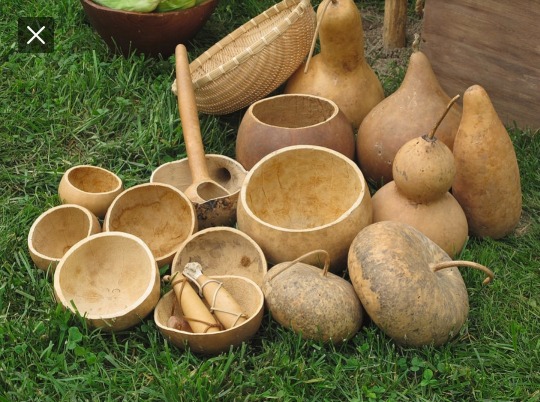
and musical instruments
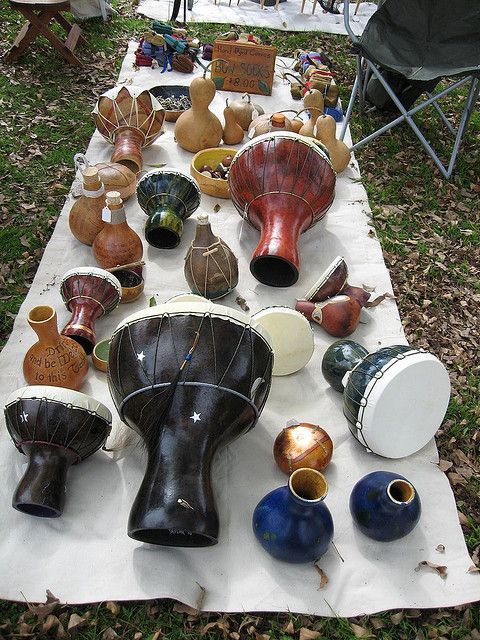

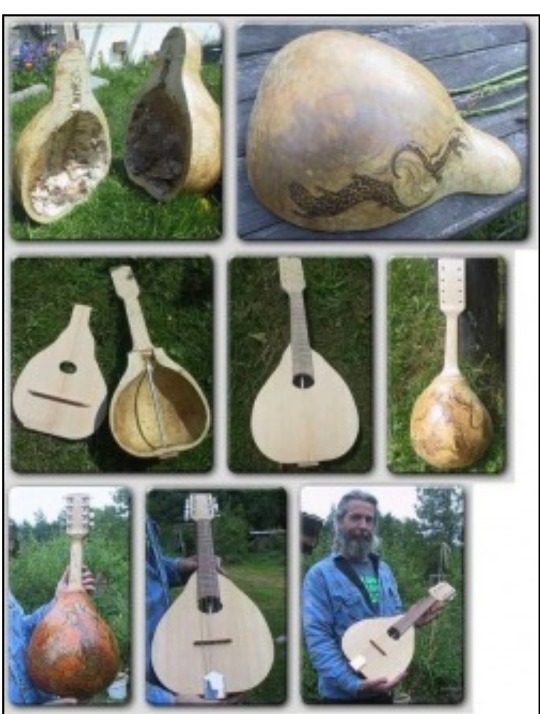
And then, people took the hollow gourds they farmed, and they turned them into houses for birds. We adapted them into the perfect houses for birds, and now there are specific breeds of birdhouse gourd just for making into birdhouses

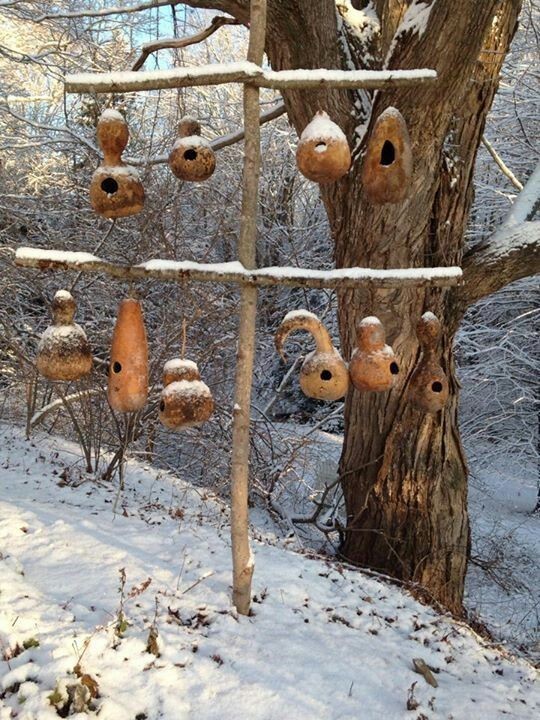
And humans dedicated gardening space and time and thousands of years of breeding to make the gourds so absolutely perfect for birds, that there is a species of bird that lives almost exclusively in them
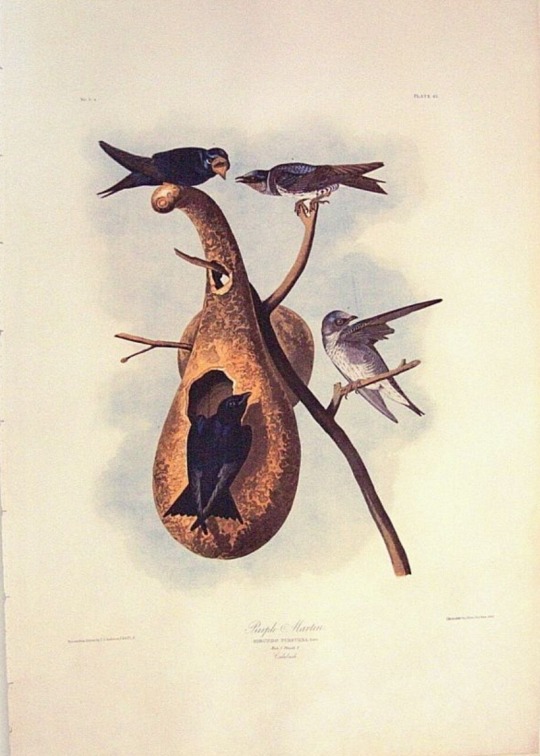
#yes I KNOW i posted about this the other day but *crying* i just love plant domestication and the history of agriculture#and humanity's positive affect on the ecosystems we live in#mine#image IDs in alt text#hmm. I'm gonna tag this#permaculture#just to pspsps @ that community to look at how cool gourds are please everyone grow birdhouse gourds and give cavity nesters places to live#i don't think mine will become fully ripe before i get my first frost :( next year i need to start gourds indoors#i didn't want to grow them before because i didn't have much garden space but now i do and i need to grow all of them#i might be. a little obsessed with gourds. but also i saw a pair of purple martins flying by the road last year#and i had never seen one before then! and i need to see more of them#i have a few hundred barn swallows but i need more birds flying around my house. more!!#and also i have a ton of invasive cavity nesting species around here. house sparrows and starlings.#gotta make up for those things competing with native birds for nest dites#*sites#the invasive birds very often win :/#that's why they're invasive#i really do need to start trapping them....
32K notes
·
View notes
Text
Life is getting harder, and so, we must get better at it.
Climate change and species extinction and ecosystem collapse are happening quickly. They are spiraling out of control. Even many Ecosystems that are supposed to be the most stable in their regions are facing decline. There are runaway effects, each thing that gets worse makes the next thing get worse faster, more disastrously. Each of these systems becomes less resilient the more of its redundancies are stripped away.
And yet, we can also have cascading effects. I am seeing controlled burns turn the plantation pines into savannas again, for the first time in 200 years, they are burning now, right now, where they would never have imagined to burn a year ago. I am seeing people talk about planting native plants. The nurseries here are selling out of them faster than they can restock. If you ask, they will say “This did not happen last year”. The foundations that have been being built by ecologists over the past half century, and maintained against brutal colonialism by indigenous peoples, are seeping out into the community. I see people talking about river cane, and pitcher plant, and planting paw paw and persimmon and sassafras and spice bush. These things are returning. Even now, in the worst drought in known history of my area, I see more butterflies than last year, because we have put in more of their host plants, their overwinters. We are learning. We are beginning. We are being born into a world of ecology; we are breaking the green wall of blur that defines our settler nonrelationship with nature. The irises are returning to Louisiana, the black bear too. The oysters are returning to Mobile Bay. I hear talk of gopher apples and river oats from the mouths of children. I see the return of the chinquapin, and her larger sister chestnut. It is slow but it is also so fast. It is growing at new trajectories, new rises. Each of these becomes it’s own advocate when planted in space and put in relationship.
We are not doomed. We must claw back from the brink. We must find each other and we must exchange seeds. We must learn to pull invasive species. We must win others over through earnestness and full bellies, through kindling the spark of ecological joy, and then we must show them the way. We must be learning the way ourselves in the meantime. We must teach the children the names we were not told, that were forgotten; how to recognize these friends.
When things are spiraling towards despair and death we must be that spiral towards life and utter utopia. We must build ourselves into full participants in our ecological systems.
As life gets harder, we must get better at it.
978 notes
·
View notes
Text
Hubert Reeves once wrote that "on the cosmic scale, liquid water is rarer than gold". And what is true for the universe is even truer in the Sahel, the name given to the vast, arid belt that skirts the Sahara and stretches across Africa from east to west.
Since 3,000 BCE, the peoples of this region have invested tremendous effort into coming up with myriad ways to capture and control this remarkably scarce resource. Faced with the poor distribution of water across space and time, they have had to resort to intelligent, thrifty methods to make the most of even the tiniest drop.
Overlooked for many years, the secrets of the Sahelian landscape are starting to pique the interest of researchers and decision-makers.
Continue Reading.
806 notes
·
View notes
Text
Machi's #15 DPxDC Idea
Bruce couldn't understand what was happening, or why, or how, or why, or when, or well, anything at all. One day he found two civilians, two teens goofing around the cave like two newlyweds. When Batman, with capital B; tried to interrogate them he only got mockery.
"What's with the long face?" They said before disappearing through one of the smaller caves. For a moment Bruce thought he had hallucinated the Asian boy and the Hispanic girl. Only to find the same Hispanic girl with a blond boy making out on Red Robin's bike. Plus another couple with them! And all of them were holding hands!
Then, a few days later, while he was investigating the lower levels of the batcave he found a black boy with a red beanie flirting with Jason, and Jason was flirting back? Batman had to pull everybody out of the caves and call for an emergency meeting. Only to find a boy with black hair passed out at the meeting table, using Batman's reports as cushions. Sitting next to him was a girl with also dark hair drinking with a straw from a coconut.
"Poor Danny," she said. "After all these years he still can't deal with alcohol." And then she promptly started to offer coconut milk to everyone.
He snapped at her but she only raised an eyebrow and left carrying the boy, Danny, on her back. And then the music started. Day and Night it would start playing at the most random moments. Samba, Rumba, Fados, Boleros, K-pop, anything went in, they even accepted petitions if the kids yelled loud enough. Steph had gotten in the habit of asking for Kill Bill's OST and Dick constantly asked for Taylor Swift. They even answered when Damian complained about their choices and asked for Chopin's nocturne. And then the batcave started to grow flowers! And trees? And the fruit was edible? What the heck?
"Sounds to me like you have a nymph infestation," said Wonder Woman after hearing his rant report. Batman stared at her like she had grown another head.
"I mean, flower powers, free love, did they have pointed ears?" Batman nood. "Yup, definitely a nymph infestation." Batman kept staring at her. Don't look at me like that, they are very common where I come from. The only solution is to wait until they get bored and move on. If you try to get rid of them violently not only you will fail. But also will risk the wrath of the gods." Batman kept staring. Wonder woman sighed. "I will call Pan to see if he is missing any nymphs and wants them back".
#machi's idea#dpxdc#dp x DC#batman#danny Phantom#prompts#Fae Danny#Fae Amity Park#Free love Amity Park#Everybody is into everybody#Sam has plant powers#So they always have food#They keep moving so they don't extenuate the soil and to let it rest#it is called letting a field lie fallow#so the soil can restore their natural nutrient balance#wonder if Luisa in Encanto does the same#bc her powers are useless without soil to grow#not to mention Poison Ivy#to make such a huge plants the soil must suffer a lot#Responsible agriculture#This tags got out of control pretty quickly#summary#Amity Park is weird#there is a massive polycule and they travel the world partying and exploring#and sometimes they do chores for CW#like finding the pools of rancid ectoplasm and cleaning them#wait until they make it to Nanda Parbat#Ras Al Ghoul will have an aneurysm#Dani will have Thalia
427 notes
·
View notes
Text
hey do me a favor and reblog this
531 notes
·
View notes
Text
There are more than 1,000 varieties of banana, and we eat one of them. Here’s why that’s absurd...
The lack of diversity could mean the fruit’s extinction. It offers a stark warning of what could happen to other key foods.
Most people don’t question why every banana they’ve ever eaten looks and tastes pretty much the same.
Most of us will never try a blue java from Indonesia with its soft, unctuous texture and flavour of vanilla ice-cream, or the Chinese banana that is so aromatic it’s been given the name go san heong, meaning “you can smell it from the next mountain”.
The demand for low-cost, high-yielding varieties has resulted in vast monocultures of just one type of globally traded banana, and this is true of many other crops as well. Homogeneity in the food system is a risky strategy, because it reduces our ability to adapt in a rapidly changing world...
Read more: https://www.theguardian.com/commentisfree/2024/mar/22/1000-varieties-banana-lack-of-diversity-extinction
132 notes
·
View notes
Text
In search of lost fruit: the explorers tracking down ancient trees before they are gone forever
434 notes
·
View notes
Text
"Vegans have clearly never been to a farm because the animals are taken care of and all their needs are met! They don't know what they're talking about!"
I don't care!
Veganism is a completely different way of viewing animals. It's not about "let's treat them nicely."
Veganism is the belief that humans should not use the bodies of animals when they don't need to do so to survive.
Veganism means that because an animal can suffer and enjoy things, they deserve autonomy. Using that animal's body for your own gain, even if you try to do so in a way that's sensitive to their happiness and health, is exploitation.
Veganism acknowledges that not every aspect is accessible to every person in the very definition of the word: not partaking in the use of animals as much as possible. It's not erasing the need for systemic change, it's just people trying to live out their ethics consistently to the best of their ability.
You don't have to tell me about how nice the animals are treated. That's usually not true anyway but even when it is, I simply do not care.
If your idea of animal rights does not include the idea that animals should have autonomy then I'm not expecting this post to convince you, but if you talk about how nicely animals are treated or about how veganism isn't accessible to everyone, you're not "owning the vegans," you're just proving that you have no idea what veganism actually is.
#vegan#veganism#animal rights#vegetarian#vegetarianism#plant based#humane farming#animal agriculture#ethics#philosophy
293 notes
·
View notes
Text
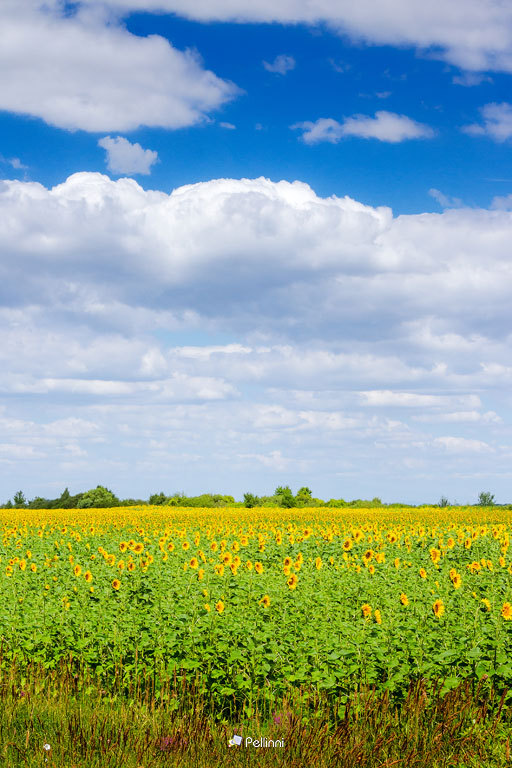
sunflower field in summer. agricultural scenery on a sunny day beneath a blue sky with cloud. plenty of agriculture production from ukraine concept
#sunflower#field#summer#flower#agriculture#yellow#background#nature#green#natural#beautiful#sky#blue#landscape#bright#plant#colorful#outdoor#sunny#season#view#environment#rural#floral#flora#light#growth#countryside#bloom#blooming
60 notes
·
View notes
Text
Researching herbicide resistance in weeds.
A decade ago, everyone said rotating applications of different herbicides was key to stopping herbicide resistance.
Then, around 2015, evidence from a large study emerged saying that this actually causes weeds to be MORE resistant, so the best thing to do is to spray a combination of multiple herbicides mixed together at once.
Now that is being called into question too. Whoda thunk it...
Herbicide resistance among weeds is only getting stronger. Recently, scientists found an annual bluegrass (Poa annua) on a golf course that was resistant to seven herbicide modes of action at once. Seven. SEVEN. Amaranth plants been found with resistance to six herbicide modes of action at once. Twenty years ago, the narrative was that resistance to glyphosate (Roundup) was unlikely to become widespread; today it's the second-most common type of resistance.
What's more, plants are developing types of herbicide resistance that are effective against multiple herbicides at once and harder to detect. Instead of changing the chemical processes within them that are affected by the herbicides so the herbicides don't work as well, they're changing the way they absorb chemicals in the first place. Resistant plants are producing enzymes that detoxify the herbicides before they even enter the plants' cells.
It took Monsanto ten years to develop crop varieties resistant to Dicamba (after weeds made 'Roundup Ready' crops pointless). Palmer amaranth evolved Dicamba resistance in five years.
So I asked, "Why are all the proposed solutions dependent on using more herbicides, when we know damn well that this is going to do nothing but make the weeds evolve faster?"
The answer is that chemical companies have the world in a death grip. They can't make money off non-chemical solutions, so chemical solutions get all the funding, research, and outreach to farmers.
But why do chemical companies have so much power?
One of the biggest reasons is the U.S. military.
In the Vietnam war, all of Vietnam was sprayed with toxic herbicides like Agent Orange, which was incredibly toxic to humans and affected the Vietnamese population with horrible illnesses and birth defects. Monsanto, the company that made the herbicides, knew that it did this, but didn't tell anyone. The US government didn't admit that they'd poisoned humans on a mass scale until Vietnam veterans started dying and coming down with horrible illnesses, and even then, it took them 40 years. (My Papaw died at 60 because of that stuff.) And the soldiers weren't there for very long. As for the Vietnamese people, the soil and water where they live is contaminated.
Similarly, during the "war on drugs," the US military sprayed Roundup and other chemicals on fields to destroy coca plants and other plants used in the manufacturing of drugs. This killed a lot of crops that farmers needed to live, and caused major health problems in places such as Columbia. The US government said that people getting sick were lying and that Roundup was just as safe as table salt. (A statement that did not age well.)
So chemical companies make money off arming the USA military. The American lawn care industry, and the agricultural system, therefore originates in more than one way from the United States's war-mongering.
The other major way is described in this article (which I highly recommend), which describes how after WW2, chemical plants used for manufacturing explosives were changed into fertilizer producing plants, but chemical companies couldn't market all that fertilizer to farmers, so they invented the lawn care industry. No exaggeration, that's literally what happened.
This really changes my perspective on all the writings about fixing the agricultural system. The resources are biased towards the use of chemicals in agriculture because the companies are so powerful as to make outreach and research for non-chemical methods of agriculture really hard to fund. All the funding is in finding new ways to spray chemicals or spraying slightly different chemicals, because that's what you can actually get ahold of money to look into. It is like the research has to negotiate a truce with the chemical companies, suggesting only solutions that won't cause lower profits.
Meanwhile my respect for Amaranth is skyrocketing.
Who would win: The USA military-industrial complex or one leafy boi
4K notes
·
View notes
Text
"In response to last year’s record-breaking heat due to El Niño and impacts from climate change, Indigenous Zenù farmers in Colombia are trying to revive the cultivation of traditional climate-resilient seeds and agroecology systems.
One traditional farming system combines farming with fishing: locals fish during the rainy season when water levels are high, and farm during the dry season on the fertile soils left by the receding water.
Locals and ecologists say conflicts over land with surrounding plantation owners, cattle ranchers and mines are also worsening the impacts of the climate crisis.
To protect their land, the Zenù reserve, which is today surrounded by monoculture plantations, was in 2005 declared the first Colombian territory free from GMOs.
...
In the Zenù reserve, issues with the weather, climate or soil are spread by word of mouth between farmers, or on La Positiva 103.0, a community agroecology radio station. And what’s been on every farmer’s mind is last year’s record-breaking heat and droughts. Both of these were charged by the twin impacts of climate change and a newly developing El Niño, a naturally occurring warmer period that last occurred here in 2016, say climate scientists.
Experts from Colombia’s Institute of Hydrology, Meteorology and Environmental Studies say the impacts of El Niño will be felt in Colombia until April 2024, adding to farmers’ concerns. Other scientists forecast June to August may be even hotter than 2023, and the next five years could be the hottest on record. On Jan. 24, President Gustavo Petro said he will declare wildfires a natural disaster, following an increase in forest fires that scientists attribute to the effects of El Niño.
In the face of these changes, Zenù farmers are trying to revive traditional agricultural practices like ancestral seed conservation and a unique agroecology system.
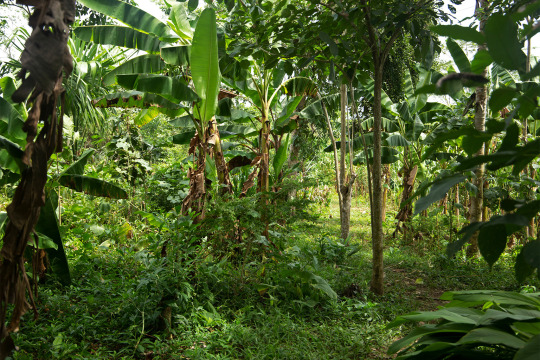
Pictured: Remberto Gil’s house is surrounded by an agroforestry system where turkeys and other animals graze under fruit trees such as maracuyá (Passiflora edulis), papaya (Carica papaya) and banana (Musa acuminata colla). Medicinal herbs like toronjil (Melissa officinalis) and tres bolas (Leonotis nepetifolia), and bushes like ají (Capsicum baccatum), yam and frijol diablito (beans) are part of the undergrowth. Image by Monica Pelliccia for Mongabay.
“Climate change is scary due to the possibility of food scarcity,” says Rodrigo Hernandez, a local authority with the Santa Isabel community. “Our ancestral seeds offer a solution as more resistant to climate change.”
Based on their experience, farmers say their ancestral seed varieties are more resistant to high temperatures compared to the imported varieties and cultivars they currently use. These ancestral varieties have adapted to the region’s ecosystem and require less water, they tell Mongabay. According to a report by local organization Grupo Semillas and development foundation SWISSAID, indigenous corn varieties like blaquito are more resistant to the heat, cariaco tolerates drought easily, and negrito is very resistant to high temperatures.
The Zenù diet still incorporates the traditional diversity of seeds, plant varieties and animals they consume, though they too are threatened by climate change: from fish recipes made from bocachico (Prochilodus magdalenae), and reptiles like the babilla or spectacled caiman (Caiman crocodilus), to different corn varieties to prepare arepas (cornmeal cakes), liquor, cheeses and soups.
“The most important challenge we have now is to save ancient species and involve new generations in ancestral practice,” says Sonia Rocha Marquez, a professor of social sciences at Sinù University in the city of Montería.
...[Despite] land scarcity, Negrete says communities are developing important projects to protect their traditional food systems. Farmers and seed custodians, like Gil, are working with the Association of Organic Agriculture and Livestock Producers (ASPROAL) and their Communitarian Seed House (Casa Comunitaria de Semillas Criollas y Nativas)...
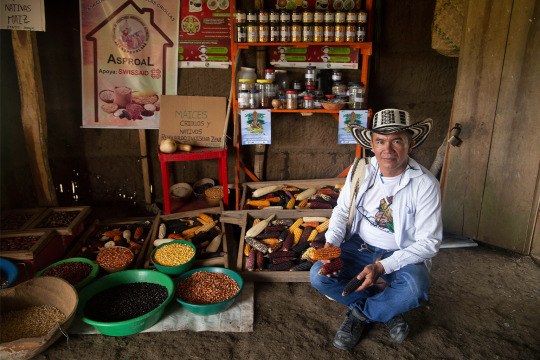
Pictured: Remberto Gil is a seed guardian and farmer who works at the Communitarian Seed House, where the ASPROL association stores 32 seeds of rare or almost extinct species. Image by Monica Pelliccia for Mongabay.
Located near Gil’s house, the seed bank hosts a rainbow of 12 corn varieties, from glistening black to blue to light pink to purple and even white. There are also jars of seeds for local varieties of beans, eggplants, pumpkins and aromatic herbs, some stored in refrigerators. All are ancient varieties shared between local families.
Outside the seed bank is a terrace where chickens and turkeys graze under an agroforestry system for farmers to emulate: local varieties of passion fruit, papaya and banana trees grow above bushes of ají peppers and beans. Traditional medicinal herbs like toronjil or lemon balm (Melissa officinalis) form part of the undergrowth.
Today, 25 families are involved in sharing, storing and commercializing the seeds of 32 rare or almost-extinct varieties.
“When I was a kid, my father brought me to the farm to participate in recovering the land,” says Nilvadys Arrieta, 56, a farmer member of ASPROAL. “Now, I still act with the same collective thinking that moves what we are doing.”
“Working together helps us to save, share more seeds, and sell at fair price [while] avoiding intermediaries and increasing families’ incomes,” Gil says. “Last year, we sold 8 million seeds to organic restaurants in Bogotà and Medellín.”
So far, the 80% of the farmers families living in the Zenù reserve participate in both the agroecology and seed revival projects, he adds."
-via Mongabay, February 6, 2024
#indigenous#ecology#agroforestry#agriculture#traditional food systems#traditional medicine#sustainable agriculture#zenu#indigenous peoples#farming#colombia#indigenous land#traditional knowledge#seeds#corn#sustainability#botany#plant biology#good news#hope#climate action#climate change#climate resilience#agroecology#food sovereignty
1K notes
·
View notes
Text
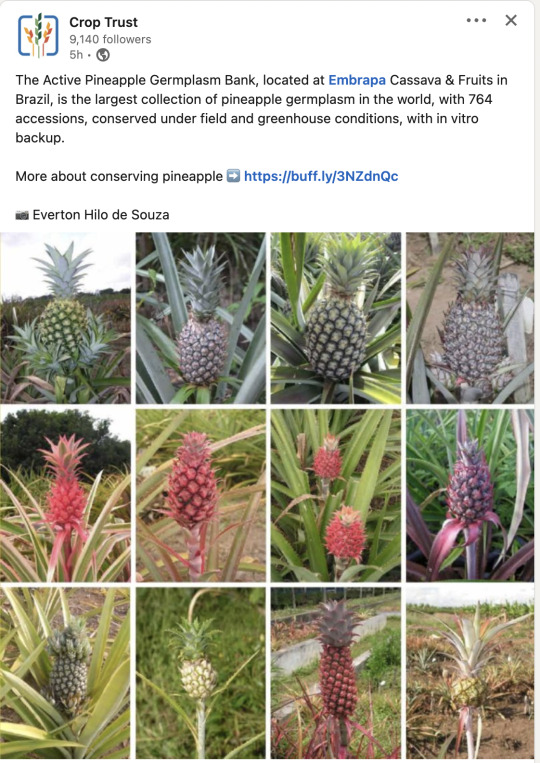
The surprising diversity of Pineapples (Ananas comosus).
The Active Pineapple Germplasm Bank (Pineapple AGB) of Embrapa Cassava & Fruits (Embrapa/ CNPMF) has more than 700 accessions under field conditions. As backups, there are copies kept in a greenhouse, with one or two plants per accession, cultivated in plastic pots with commercial substrate. An in vitro gene bank was established in 2003, and during the past few years, several studies have been carried out to improve the in vitro conservation protocol. Currently, about 60% of the AGB’s accessions are preserved by this protocol. Another conservation strategy used is cryopreservation of shoot tips and pollen grains, with well-defined methods. One of the most significant advances in the pineapple germplasm conservation has been the implementation of a quality control system, which enabled to define standard operation procedures (SOP) towards a more efficient and safer germplasm conservation.
Source:
Vidigal Souza, Fernanda & Souza, Everton & Aud, Fabiana & Costa, Eva & Silva, Paulo & Andrade, Eduardo & Rebouças, Danilo & Andrade, Danilo & Sousa, Andressa & Pugas, Carlos & Rebouças, Érica & França, Beatriz & França, Rivã. (2022). Advances in the conservation of pineapple genetic resources at Embrapa Cassava and Fruits. 28. 28-33.
#katia plant scientist#botany#plant biology#plant science#plants#fruit#pineapple#pineapples#biodiversity#agriculture#conservation#genetic diversity#sustainable agriculture#tropical plants#science#biology
321 notes
·
View notes
Text


iowa corn & iowa beans - holga 135 & 400 speed color film - developed at bergen photo & scanned with minolta dimage dual iii
#farm#field#35mm#green#cloudy#landscape#prairie#great plains#midwest#iowa#americana#film#film photography#35mm photography#ishootfilm#photography#lensblr#plants#agriculture#farming
185 notes
·
View notes